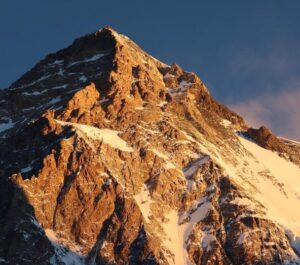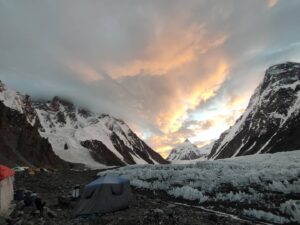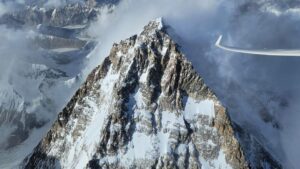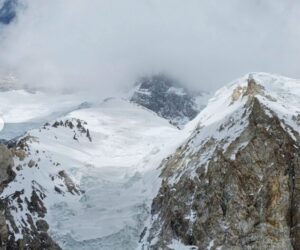It is better if members of your team don’t fall into what I call Group Think across expeditions because when that happens, thinking falls to the lowest common denominator and it is not usually fight—it is flight.
On July 28, 2017, Vanessa O’Brien led the only team to successfully summit K2 in 2017, thereby becoming the first American woman to summit the difficult 8,611-meter peak. Explorersweb sat down with Vanessa to talk about her experience – from the difficult conditions on the mountain this year, to team dynamics, to the psychological changes that result from achieving ones goals. In the first of this three-part exclusive, Vanessa gives an insight into what it takes to form and lead a successful team.
—
ExWeb: You summited K2 this year after two unsuccessful attempts. Conditions were far from favorable and your summit attempt took an arduous 16 hours. What was different this year that enabled you to make the summit?
Vanessa: “I think K2 is just summited so infrequently that people forget sometimes a summit on K2 can take up to twice as long as a summit on Everest. For example, in 2004, Edurne Pasaban took 15 hours, arriving at K2’s summit at 5 pm. In 2014, three female Sherpa took 16 hours, arriving at K2’s summit at 3:35 pm. This year our team took 16 hours, arriving at K2’s summit at 4:40 pm.
I was extremely fortunate to summit K2 on my third attempt knowing it has taken others like Gerlinde Kaltenbrunner seven attempts to do so. I can only commend her for her determination not to give up. Since 1986, there have been 12 years of no summits, ergo; there is a 40% chance in any one year that K2 will not be summited.
But there were two things that were different this year that worked in our favour. First, there were fewer teams on the mountain. This is important because routes have bottlenecks and camps have limited space. It is better if members of your team don’t fall into what I call Group Think across expeditions because when that happens, thinking falls to the lowest common denominator and it is not usually fight—it is flight. This is when fear takes over and everyone looks for reasons to go home.
The second thing in our favour was that our team was prepared to fix the entire mountain, if it came to that. That is, if conditions called for fixing and if other teams didn’t pitch in, we were prepared with the manpower and supplies to do it ourselves. Our summit bid consisted of extremely deep snow, horrific winds, increasing precipitation, and freezing-cold temperatures. It is these conditions in which we put in fixed lines, knowing the weather would slow our pace and force us to descend in darkness.
I was worried when we were ascending, as all the other teams had turned back, but as I looked around for signs of frostbite or fatigue in my teammates they were all strong. No-one flinched, ducked, baulked or shied away from the conditions. They came from Iceland, China, Nepal and Pakistan or, like myself, had been to the North and South Poles. Each had climbed from four to thirteen 8,000-meter peaks. Whatever Mother Nature was going to give, we were collectively willing to receive, so unless an act of God were to throw some misfortune our way – we were going to summit and descend.”
ExWeb: Without your initiative in putting the expedition together, there wouldn’t have been a summit of K2 this season. As the expedition leader and with your two previous attempts on the peak, what was your role in the success of the team?
Vanessa: “In 2015, I joined a large Western expedition but realized that these expeditions, while successful on Everest, would not work on K2. While I am generalizing, I feel large Western expeditions have client bases that are too diverse and their leadership style is too risk averse for a mountain like K2.
In 2016 I attempted to lead my own expedition to K2, but realized that the Sherpa would not take instruction from me. It is not because I am a woman, or even about economics, it is more complicated than that. It’s more about whether I am a long-term employer. Think about the things you will do for an employer you have a long relationship with versus what you are willing do for someone you just temp for on a two-month assignment and might never see again. Obviously, you not going to go the extra mile and risk your life for the latter. The Sherpa saw me as a temporary employer and therefore I had limited ability to influence them.
I met Mingma Gyalje Sherpa in 2016 and we decided to plan our expedition to K2 together in 2017. The first thing I did was to switch Mingma’s local operator to Nazir Sabir Expeditions (NSE). NSE is one of the best in the business – and you want people on the ground that can get things done. By this I mean everything, from permits to securing the best high altitude porters (HAPs), to getting regular porters, and—God forbid—helicopter rescue. I also requested my previous cook because with over 30 years of experience he is more like a Sirdar. Lots and lots of issues simply disappear all because I have a local partner I can trust.
As Pakistan’s Goodwill Ambassador, it is easier for me to arrange some local logistics. I make sure ALL of my resources – people, equipment, supplies, and oxygen (a hazardous material), are transported together and in a timely fashion. If the planes are not flying between Islamabad and Skardu (which is often the case), my role as allows me to arrange a C-130 cargo flight that can take everything and everyone by air rather than risk health, time and security issues taking the Karakoram Highway. This is a last resort of course, but it happened this year.
So outside of security, logistics, and choosing local suppliers my other job is to partner with our Military Liaison Officer to ensure our expedition is a success and we respect our environment. I am also liaison to the Pakistan Alpine Club who we meet before, and if successful, will grant our summit certificates afterwards. I am the lead medical member for the team as Dr. Peter Hackett builds my medical kits and I have gained experience in high altitude medicine over the years. I always carry enough medicine for my entire team. This year we treated half a dozen porters on route to K2 base camp at every camp.
As expedition leader I am also the decision-maker, which can make me popular or unpopular. While everyone tries to be collegiate, someone has to make an actual decision and say “Yes” or “No”. Because my name is on the climbing permit, that person usually ends up being me. So if the porters arrive at K2 Base Camp and set up in the wrong place, I’m “Bad Cop” and make them move further down the glacier. If Mingma Gyalje Sherpa proposes we work with another team on our summit bid and it doesn’t make sense, I’ll say so. And if the Sherpa throw their cigarette butts on the glacier – well, I’m the one making them pick them up. However, sometimes I try to be “Good Cop” – increasing morale by showing movies and inviting other teams round for things like our infamous K2 Quiz.
Mingma Gyalje Sherpa led his own expedition to K2 in 2016 so he isn’t the type who needs micromanaging. He led the rope fixing team and was in charge of the weather forecasts. Each climber was in charge of setting up their own acclimatization schedules because we had some climbers with no previous acclimatization before coming to K2 and others who had just completed two 8,000-meter peaks. 58% of all summits on K2 have historically taken place between 20 July and 1 August – so everyone knew roughly what summit window to work toward. As far as weather, I had four years of actual, historical weather reports that I joked with Mingma Gyalje Sherpa would be more accurate than his forecasts. I climbed primarily with Dawa Gyalje Sherpa, brother of Dawa Yangzum Sherpa who had summited in 2014. We didn’t climb as a team of 12 until summit day. Both Mingma Gyalje Sherpa and I came down the mountain last to ensure everyone was safe and all camps were cleared.”
—
In the second part of the Explorersweb interview with Vanessa O’Brien, we ask why she thinks no other team was successful in summiting this season, and how she feels the achievement changed her.






